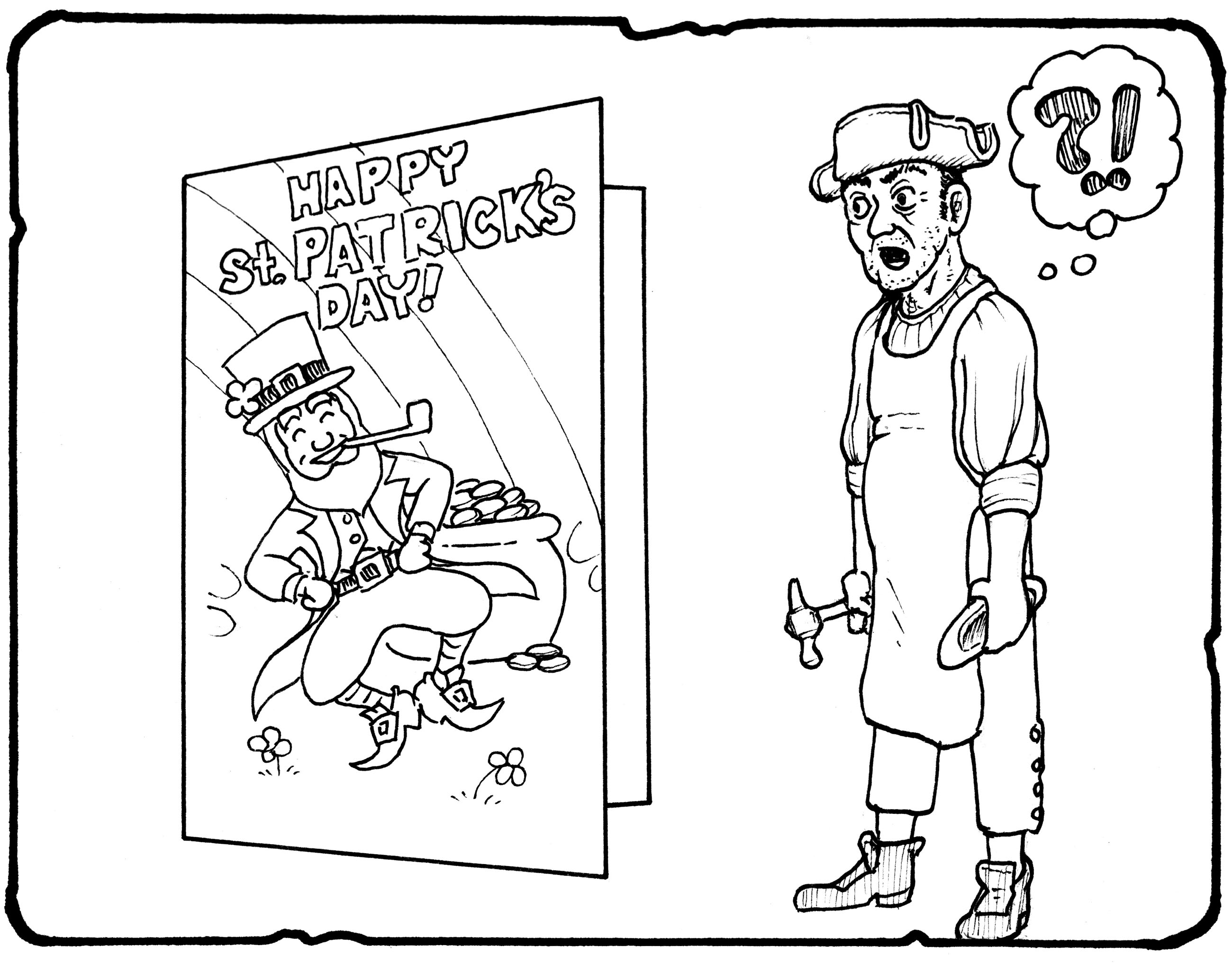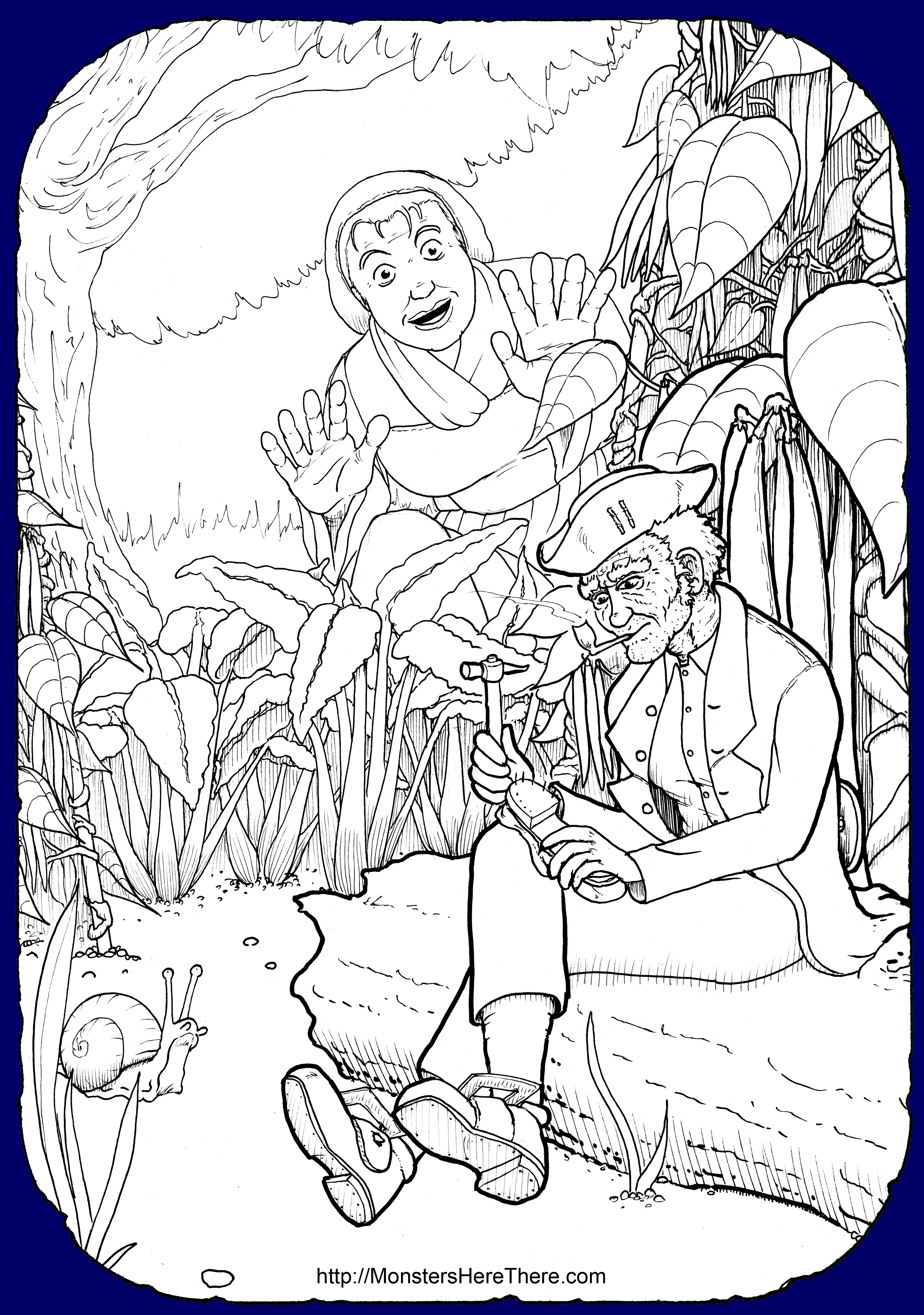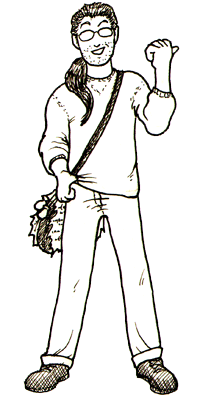| Area(s) Reported: Ireland
Date(s) Reported: 1639 to Present (possibly earlier)
It's been said that the world outside of Ireland first heard of "lubricans" in 1604, when they were mentioned in passing in a play of questionable merit: "As for your Irish lubrican, that spirit / Whom by preposterous charms thy lust hath rais'd / In a wrong circle." ... which pretty much tells you nothing about leprechauns, does it? What I can prove is that "leprighauns" were mentioned in an 1814 novel by Irishwoman Lady Morgan. In the notes to her novel, Morgan gave a short explanation of this odd Irish fairy, mindful that she may have readers who were not Irish themselves. As she explains, 'leprighauns' are an Irish fairy that looks like a "shrivelled old man," and whose appearance marks the location of a treasure that was buried during "the troubles"... which was a reference to a series of wars between 1639 and 1651 that involved Ireland, Scotland, and England as the power of the English monarchy was challenged and re-written. So basically, the leprighaun reveals the locations of forgotten loot hidden during the national emergency. Morgan further explained that this fairy was generally seen in "lone and dismal places, out of the common haunts of man" -- after all, where else would you bury a treasure? -- and she implies the leprighaun were generally seen at night. Of course, showing where a treasure is wasn't the same as saying anyone could just have it... if a person was out at night and lucky enough to spot a leprighaun, they could mark the spot they saw the fairy man. Yet by the time they returned in daylight with the tools to dig it up, the marker would have been duplicated and spread out enough to completely disguise the original location! "Why wait?," I hear some of you ask... fairies generally disappear when the sun rises, so it's entirely probable that the leprighaun sat on top of the treasure until then anyway. Good luck digging under a fairy! In 1825 T. Crofton Croker published his collection of Irish fairy tales and legends, and gave a slightly different idea of what these 'leprighauns' were. Unfortunately, Croker conflated these fairy men with another monster, and called both 'clurichauns,' which led to some confusion later. The reason for this error was simple; the two creatures shared some unique elements that led Croker to believe the names 'leprechaun' [as Croker spelled it] and 'clurichaun' meant the same thing. Both of these strange beings are members of the group of monsters known as fairies that are reported throughout the British isles; and both are a form of fairy unique to just Ireland. In appearance, both look like a little old man, generally about the size of an average person's hand. Unlike other fairies, both of these were generally loners -- most fairies were encountered in groups. What distinguishes the two beings from one another is their behavior, as later researchers defined the matter. 'Clurichauns' are all about obsession with alcohol and causing trouble; 'Leprechauns' are all about making shoes and finding treasure. Yes, that's right... leprechauns make and mend shoes, theoretically for others fairies; the shoes are always teeny-tiny fairy sized. Croker also mentioned that they were believed to smoke ancient pipes called Dudeen, which were often found as farmers dug or plowed in fields. Leprechaun Encounters Croker related three accounts of leprechaun encounters, with at least one claimed to be a personal experience of the person interviewed. The witness in this case was a very old woman named Moirna Hogaune, who told how a little after her marriage many years previous she had been knitting out in the sunshine near her house when she heard a strange ticking noise. Upon investigating, she found herself looking at a very tiny man in her garden by the beans. He had a Dudeen pipe in his mouth, a cocked hat on his head, a jacket with big buttons on the back, and shoes with silver buckles so big they almost covered his feet. Hogaune, well aware of the opportunity in front of her, quickly snatched up the man and threatened to cut off his nose if he didn't take her to his purse of money (she was bluffing, by the way). Frightened and unable to escape because Hogaune wouldn't take her eyes off of him, the leprechaun agreed to lead her to his money "just a couple of fields off;" but then she heard an ominous buzzing sound. She and her husband had beehives, and they were expecting the bees to swarm; they'd been keeping a careful watch on them to know when to set up a new hive. The little man, looking alarmed, shouted that the bees were swarming and flying away, and Hogaune immediately looked... and knew instantly that she'd allowed herself to be tricked. The bees were not swarming; and with her eyes off of the leprechaun, he had escaped from her hand as easily as smoke. A young woman named Molly Cogan told about her grandfather's encounter with a leprechaun, a story she had heard numerous times from both him and her mother. One evening her grandfather went out to the stable to check on a tired horse, and heard someone tapping a small hammer and whistling inside the stable. So he stealthily snuck into the stable, and inched around following the sounds until he discovered the leprechaun; he was working on a shoe while sitting under the tired horse! The little fairy wore a red nightcap and an apron, and was so engrossed in his work that he didn't notice the grandfather at all until he'd already been snatched up by him. The grandfather declared he'd never let go until he got the purse, and the little leprechaun pleaded for him to stop grasping so hard so he could get it; obligingly, the grandfather allowed his grip to loosen just a little, to stop hurting the fairy... and the leprechaun was out of his hand in the same instant. Angry though the grandfather was at this lost chance, he did gain one odd prize... for the leprechaun had left behind the tiny shoe he had been crafting, and for many years the shoe stood as proof of the tale until it was eventually lost. Croker's last story, which may or may not be a witness account, tells of a 29-year-old man named Tom Fitzpatrick who also heard a light hammering sound, while outside one day. He followed the noise to a brown pitcher holding about a gallon and a half of liquor, hidden in a hedge... and, as he watched, Fitzpatrick then saw a tiny man pull out a stool to climb up and fill a cup just his size from the pitcher, before sitting down beside it to work on a shoe. The leprechaun was wearing a leather apron, and had a cocked hat on. Knowing the common fact that he mustn't take his eyes off the leprechaun, Fitzpatrick slowly approached the little man and struck up a conversation with him. Among other things -- somehow not surprisingly -- Fitzpatrick asked what he was drinking. The leprechaun was proud to say it was a good beer of his own making, created using heath rather than malt, a thought that made Fitzpatrick laugh. The little fairy tried to distract Fitzpatrick and turn his eyes away, but the man caught on to the trick and quickly scooped up the leprechaun (spilling the beer in the process!). Fitzpatrick looked so threatening that the leprechaun agreed to lead him to his treasure, a "crock of gold"; and so they walked off to a field a little ways away that was full of ragweeds. The little fairy directed Fitzpatrick to one big bush in particular, and told him that the crock was buried under it. Fitzpatrick hadn't brought a shovel so, after releasing the leprechaun with heartfelt well wishes (which the leprechaun most assuredly didn't return), he tied one of his red garters to the bush to mark it, then ran home and back as fast as he could to get the shovel. And when he returned, every single bush in the forty acre field had an exact duplicate of his red garter tied to it; and so Fitzpatrick never found the crock of gold. I wonder if he thought to sell the garters, though... Croker's three tales became the starting point for many fictional tales about leprechauns for decades after his book was published; and though other researchers were finding new and different tales regarding these little fairy men, Croker's tales remained the main stories referenced, for his book was continually reprinted for decades after its initial publication. In fact, it was 78 years before someone else caught the public's attention enough to offer up a differing, fictional, version of the leprechaun. Darby O'Gill and the Good -- or Little? -- People In 1903, Hermione Templeton Kavanaugh released her book Darby O'Gill and the Good People, a compilation of short stories she had published in McClure's magazine from 1901 to 1902. The stories/chapters follow the title character Darby O'Gill as he has a series of adventurous encounters with various creatures of Irish folklore and legend, starting with being kidnapped by the fairy folk for sixty days. It's Darby's second adventure that concerns us here, though, for in it he deals with a leprechaun; but Kavanaugh has changed what prize the leprechaun holds. In her story, catching a leprechaun gets you three wishes! Of course, the leprechaun will try to make the wishes go horribly wrong if you aren't very careful; and if you foolishly make a fourth wish, then all the wishes are gone... it's this last rule that catches O'Gill not paying attention. After successfully wishing for a castle, endless wealth, and to own all the land surrounding him, O'Gill is tricked into idly wishing for salt for his dinner and loses all the wishes made before. The idea of leprechauns giving out wishes was continued in the stage musical Finian's Rainbow, which was performed 725 times on Broadway in New York City starting in 1947 (which is a big deal, folks!). The title character, Finian, is an Irishman who moves to the United States to hide a crock of gold he'd successfully stolen from a leprechaun... who's in hot pursuit of the wily man. The leprechaun is slowly becoming human without the magic crock, which can grant three wishes; but if all three wishes are made, then the magic and gold vanishes forever. The next most notable leprechaun related entertainment would be Walt Disney's 1959 film based -- loosely -- on Kavanaugh's book, which he renamed Darby O'Gill and the Little People... a title change aimed at an audience that would be largely unfamiliar with Irish culture, but would know what a 'fairy' was. Disney went out of his way to paint his movie as being based on genuine Irish folklore; but then took Kavanaugh's 'four wishes' idea, and expanded further on his own. In Disney's presentation, the word "leprechaun" was used to just generally mean "fairy;" the so-called 'leprechauns' lived in a large society, and even sported a "King of the Leprechauns." Their chief occupation, as presented, was dancing and drinking; not making and mending shoes. In short, they were by no means leprechauns! Disney's film seems to be the trigger that had the effect of making the leprechaun a symbolic ambassador of Ireland itself. Images of leprechauns did exist outside of Ireland previous to Disney's movie, but these were more just interesting curiosities, and showed the older style of leprechaun, working on shoes and dressed as a generic elf or fairy might be... pointed red cap, lots of browns, greens, and reds in their outfits. 
After Disney's 1959 movie came a large number of leprechaun representations, starting with those that imitated Disney's... but then the images started to be merged with a pre-existing set of ethnic stereotype images of Irish men that had existed in America throughout the 20th Century. Irish men, in cards and other novelty items sold at the start of the twentieth century, were almost always shown wearing green, in an older style of clothing that included knee-breeches (pants that go down to the knee), vest and coat, brass buttons and silver buckles on clothing and shoes, and often wearing a short top hat which was also green. These "Irishmen" were associated heavily with the image of a shamrock -- a standard clover leaf (not a four-leaf one!) -- and often shown smoking or holding a long pipe with a barrel end. They usually had red hair, often with a red beard... and all of these ideas attached themselves to the new, symbolic image of a leprechaun, shifting the existing social stereotype from actual people to the monster which was less likely to complain about the matter. Other ideas also attached themselves to this new semi-international idea of what a leprechaun was. It's likely thanks to Finian's Rainbow that Disney had Darby O'Gill wish for a 'crock of gold' from a leprechaun (which O'Gill soon lost); and it's probably because of Disney that leprechauns are now thought to have a crock of gold as the treasure they offer... no other options! Finian's Rainbow returned in 1968 as a movie, which allowed for a larger, international audience to see the story then had been possible back in 1947 when it was just a stage production. The movie's 'leprechaun' was played by a young red headed male lead, who wears a velvety green jacket with a short green top hat; so it helped cement the newer image that was forming of the leprechaun. It also seems that Finian's Rainbow is responsible for one other idea that has become a standard folklore attached to this newer leprechaun. Here are a couple of clues: the place Finian settles in and buries the stolen crock of gold is called "Rainbow Valley"... and at the end of the movie when Finian sets off on his own after his daughter's wedding and the loss of the crock of gold, he says he's off "To find me a rainbow; Finian's rainbow! ... Sure'n there may not be a pot of gold at the end of it, but there's a beautiful new world under it." The original 1947 stage production of Finian's Rainbow seems to be the first time it was implied that leprechauns could hide their treasure at the end of a rainbow; and this idea seems to have only become a well-known 'fact' about leprechauns after the 1968 movie was released. Given the reputation that leprechauns had for being tricky, and exactly how hard it would be to ever reach the end of a rainbow, the story seems to have been just too good an idea... and so it stuck to the developing new stereotype image of a "Leprechaun." So, there you have it. Leprechauns appear to have existed, as actual witnesses reported them in the past... but if you go looking for what most people think a "Leprechaun" is now, you really are chasing rainbows! | |








